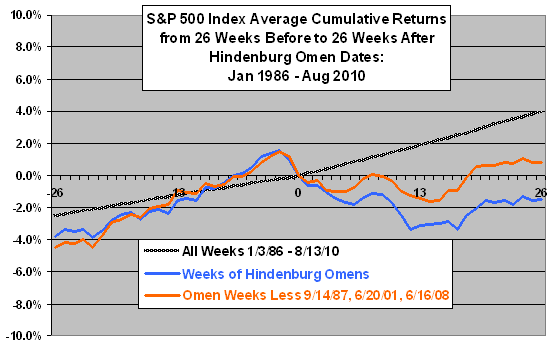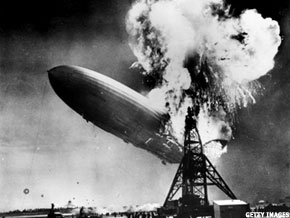The Omen's Criteria
All criteria must be met for a confirmed occurrence.- The daily number of new NYSE 52-week highs and the daily number of new 52-week lows must both be greater than 2.5% of the total issues traded that day.
- The smaller of the 52-week highs and lows must be greater than or equal to 79 (or 2.5% of 3,168 issues).
- The NYSE's 10-week moving average must be rising.
- The McClellan Oscillator, a measure of market fluctuations, must be negative.
- New 52-week highs can't be more than twice the new 52-week lows. (However, it is acceptable for the new 52-week lows to be more than double the 52-week highs.)
The Omen was behind every market crash since 1987, but also has occurred many other times without an ensu. ing significant downturn. Market analysts said only about 25% of Omen appearances have led to stock-market declines that can be considered crashes.
"The Hindenburg Omen does show some deteriorating internals, which signals some major concerns," said Ryan Detrick, senior technical strategist at Schaeffer's Investment Research. "But it isn't a reason to move to 100% in cash. We're taking a wait-and-see approach, but considering its recent history, we're considering it more than other indicators."
Se volete saperne di più potete dare un'occhiata anche qui.
 Bisogna però stare molto attenti a tirare delle conclusioni sugli indicatori di crash: il campione statistico che si ha a disposizione è limitatissimo (è curioso che nessuno abbia provato a verificarne l'affidabilità su altri mercati, come ad esempio quello inglese, tedesco o giapponese...se qualche lettore è in grado di indicarmi qualche referenza bibliografica o qualche post sul web a questo riguardo gli sarei molto grato). Una discussione dell'affidabiltà di questo indicatore che solleva la questione del rischio di data mining e overfitting of rules to historical data è svolta nel blog di CXOadvisory. In particolare l'efficacia dell'Omen sembra essere dovuta al successo nell'anticipare i crolli del 1987, del 2001 e del 2008, come indica la figura qui accanto. Tenete presente che dal 1986 ad oggi si contano 27 segnali in tutto.
Bisogna però stare molto attenti a tirare delle conclusioni sugli indicatori di crash: il campione statistico che si ha a disposizione è limitatissimo (è curioso che nessuno abbia provato a verificarne l'affidabilità su altri mercati, come ad esempio quello inglese, tedesco o giapponese...se qualche lettore è in grado di indicarmi qualche referenza bibliografica o qualche post sul web a questo riguardo gli sarei molto grato). Una discussione dell'affidabiltà di questo indicatore che solleva la questione del rischio di data mining e overfitting of rules to historical data è svolta nel blog di CXOadvisory. In particolare l'efficacia dell'Omen sembra essere dovuta al successo nell'anticipare i crolli del 1987, del 2001 e del 2008, come indica la figura qui accanto. Tenete presente che dal 1986 ad oggi si contano 27 segnali in tutto.






Nessun commento:
Posta un commento